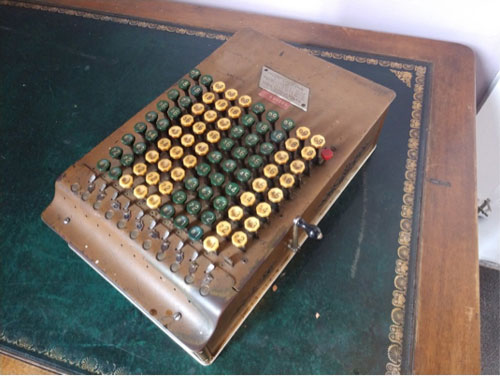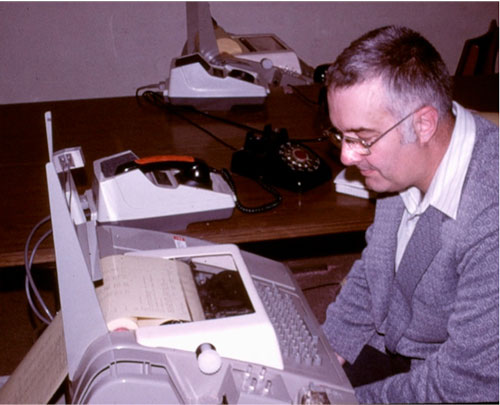By Dick Whitney, Carl Zeiss Vision, ANSI Z80.1 Chair / Vision Council Lens Tech Committee Chair/ Exec Director of Optical Heritage Museum

1911 model of a Comptometer used at American Optical –
Optical Heritage Museum photo
I have been reflecting on how computing technology has changed during my 44 year career at American Optical / Sola / Zeiss. I serve as the Executive Director of the Zeiss sponsored Optical Heritage Museum in Southbridge, MA, where American Optical was founded, and recently worked on a display of computing devices commonly used in the 20th century at AO. During this time, I have gained a great appreciation for what was achieved in ophthalmic lens design prior to today’s computer age.
While some may think of the evolution of spectacle lens designs that have occurred, understanding what tools were used to compute the designs is not examined as frequently. Our Museum collection includes early calculation devices such as the Comptometer. The model on display is from 1911, but it is likely AO had earlier models, as this device was first patented in 1887. While it is basically an adding machine and certainly used in Finance/payroll, I am sure designers found it useful as well.  Another calculation tool I am old enough to admit that I have used, is a slide rule. The slide rule pictured here was used by my father Don Whitney, who started working in the AO Lens Design department in 1947. His mentors, ‘Doc’ Edgar Tillyer, Dr. Estelle Glancy and John Davis used similar slide rules. To determine the path of a ray through a lens, many calculations were needed, a task that would take many hours done in this manner. Today this can be done on our cell phones or computers with the almost instantaneous results. Dr. Glancy holds the US patent for progressive lenses, and pondering how one would design a progressive without a computer makes this and other design achievements all the more remarkable!
Another calculation tool I am old enough to admit that I have used, is a slide rule. The slide rule pictured here was used by my father Don Whitney, who started working in the AO Lens Design department in 1947. His mentors, ‘Doc’ Edgar Tillyer, Dr. Estelle Glancy and John Davis used similar slide rules. To determine the path of a ray through a lens, many calculations were needed, a task that would take many hours done in this manner. Today this can be done on our cell phones or computers with the almost instantaneous results. Dr. Glancy holds the US patent for progressive lenses, and pondering how one would design a progressive without a computer makes this and other design achievements all the more remarkable! Turning to the mid-20th century, American Optical was one of the first to utilize the IBM 650 mainframe computer after it was introduced in 1953. The IBM 650 was the world’s first mass produced computer. Data was read from punch cards and magnetic tape. AO lens designer Audrey Carlen, who worked at AO in the mid-1950’s, recently told me that the only time the computer was available for her was at 2am! Time was precious, and back then computer time was at a premium.
Turning to the mid-20th century, American Optical was one of the first to utilize the IBM 650 mainframe computer after it was introduced in 1953. The IBM 650 was the world’s first mass produced computer. Data was read from punch cards and magnetic tape. AO lens designer Audrey Carlen, who worked at AO in the mid-1950’s, recently told me that the only time the computer was available for her was at 2am! Time was precious, and back then computer time was at a premium.
As use of the mainframe computers expanded and their computational capability increased, communication via teletype was one method used to run programs on the computer. What was typed on the teletype was transferred to paper roll punch tape and then connected via telephone. The photo is one I took of my father in 1973 at such a teletype. To input commands, one would type a line in a basic program and a response to a calculation would subsequently show in a typed response when the equation or calculation was completed.
Many other calculators such as the Monroe were used for decades in the lens department, but I personally did not have experience with those. Early in my career, I did have experience using a mini-computer made by DEC, called the MINC . It was a standalone computer and AO used it for our packaging system in AOLITE FSV lenses. Lens powers were read on a 1980 Humphrey Lens Analyzer and packaging printed on demand. This was a fun and challenging project!













